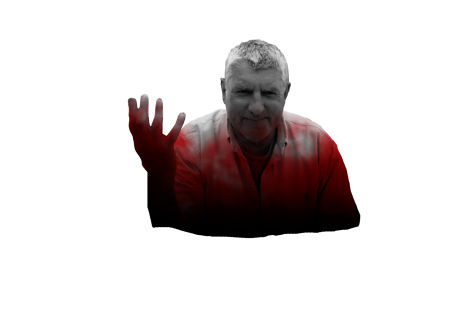The dark side of funny
October 24, 2018
How many babies does it take to paint a house? Depends how hard you throw them.
How do you get 100 babies in a bucket? A blender.
What’s the best thing about dead baby jokes? They never get old.
Some would find these jokes — darker counterparts of common jokes — offensive. Others, such as junior Ellie Damozonio, find them funny, not because she feels they’re typical humor, but because of their unexpected nature.
“I find them funny and I don’t know if that makes me a bad person,” Damozonio said. “It’s so unrealistic and unexpected that there’s almost a level of discomfort when the person hears it, so that the only reaction they can think of is to laugh. [Dark humor jokes] are very strange things”
Like Damozonio, senior Varshini Srikanthan also appreciates dark humor, but she prefers the satirical aspect of it. She emphasizes the importance of reading the audience because the appropriateness of a joke varies depending on the audience. If a man makes a sexist joke in a room full of women, she feels that isn’t okay.
For AP Physics teacher Jim Birdsong, his audience is typically students, who are greeted with his creative physics problems on tests and worksheets: a stupid man shoots a gun straight up in the air, the ‘stupid’ referring to his lack of intellect when it comes to knowing that the bullet will come straight back down. People — or even muskrats — getting hit by hammers and rocks are a few of the numerous problems that show up on his tests.
According to Birdsong, he has enjoyed dark humor since the age of eight, crediting this passion to his childhood friends who were always playing and cracking jokes with each other.
“My friend group, that’s the way we were. I never knew any different,” Birdsong said. “There were people way funnier and more wicked than me, and now they’re all bankers and lawyers so I don’t know how they get it out of their systems anymore.”
Shocked is the common response that Birdsong receives for his somewhat crude sense of humor. However, he’s okay with students’ emotional responses.
“It could be unmemorable and make them mad, which I’m torn about about, but generally, it seems to work,” Birdsong said. “But [most students] like it and seem to smile more often than not during class, so I guess it’s okay.”
Classroom environments aside, Birdsong also says there is a point where dark humor can get offensive — a point that he himself used to often cross.
“I’m bad at gauging [that point], and I tend to go until I go too far, but I’ve made all those mistakes a long time ago, so I know pretty much where I need to stop,” Birdsong said. “But it never is [meant to] and I think it clearly is not meant to be hurtful.”
For junior Nikitha Fernandez, joking about people who have endured something difficult can be taking it too far.
“Saying [an offensive] joke in front of someone who’s lost a family member or someone close to them is really harmful,” Fernandez said, “It minimizes the pain that they’ve been going through.”
While she doesn’t want to control what people say, both Fernandez and Srikanthan consider that jokes about historical events like 9/11 or the Holocaust — essentially situations where people have undergone trauma — to be completely inappropriate. In contrast, art teacher Jay Shelton himself has cracked a joke along those lines.
Around 13 years ago, during a tsunami in Japan, Shelton overheard several Japanese kids in Yearbook late night discussing the aftermath of the event.
“[A student says] all those people got washed [into] the sea,” Shelton said. “And I go ‘I know, the worst part is going to be like [in] a week when all the dead rise up out of the ocean and come out and start eating everybody [and] it’s going to be worse.”
Everyone looked at him as if he were crazy. Nobody laughed, except Shelton himself. Typically, if someone is offended by Shelton’s joke, he will feel bad and try to reach for a kind of compromise. He’ll apologize, but he will also urge them to admit the joke was funny. More often or not, they’ll concede. Ultimately, humor can be anything for Shelton.
“[Humor] is not filtering yourself,” Shelton said. “I know sometimes I’m going to say something terrible that’s going to upset somebody. But [another] part of me says, ‘Well, I’ll never get this moment to say this this way right now.’”
He believes there’s few boundaries or exceptions — if the audience right in front of the speaker laughs, it’s humor, even if the rest of the room is left shocked.
“If your goal is to be funny, and this is funny to you, and you say it, there’s no line,” Shelton said.
However, in present society, Shelton notices he’s been witnessing less and less of the above mentality. According to Shelton, people have begun to take offense, not because they’re genuinely offended, but rather due to the “checkoff list” in the back of their mind — not a list they made up, but rather what they have been told to watch out for, such as racist or sexist comments. Instead of letting the reality wash over them, Shelton believes that people have ‘learned’ to be offended anytime a joke makes light of an item on the so-called checkoff list.
However, even as a millennial, Srikanthan believes she doesn’t have much of a pre-formed checklist. As an avid feminist, she’s heard jokes about sexism and feminism but wasn’t personally offended. She’s laughed at dark jokes on the feminist movement, and admits that some of the humorous critiques are valid.
Fernandez, too, acknowledges that political dark humor can often lighten the mood, especially in the current, often divisive and difficult to deal with political climate. Like Srikanthan and Fernandez, Birdsong understands that dark humor can definitely have a positive effect, specifically when it comes to making the educational material memorable for all of the students.
“There [is] an objective to the madness,” Birdsong said. “I do weird examples and try to do funny things because it’s more likely to be remembered — if there’s a hook to get the student to remember the content, they are more likely to remember the physics when they recall the funny part of the example or explanation. That’s the goal.”
Birdsong recalls his former high school teachers and college professors — the ones he remembers and learned best from were the ones who had incorporated humor into their lessons.
“I try to say something in a different way to be more memorable, and humor is one way to do it,” Birdsong said. “You can say something deep and profound, or you can say something funny. I can only be funny, so that’s what I do — or try to do.”
Regardless of the type of dark humor, be it offensive or something to chuckle at, it has an effect on the people who hear them. In fact, a student of Birdsong’s for three years even presented him a folder with all of his dark jokes — an indication that his teaching approach was definitely a memorable one for the student. Birdsong believes that high school, especially, is the perfect stage to for dark humor.
“Elementary school is like ‘don’t let them eat glue.’ Middle school is all about ‘don’t let them kill each other.’ College is all about content — [the professors teaching] are paid to do research, so whether or not someone remembers is not as important to them,” Birdsong said. “High school is good for [dark humor]; it can actually be useful.”
However, he does believe that at times, students don’t want the negative humor, they simply want information.
On the other hand, there is a different, even darker aspect of dark humor — jokes such as the frequently heard statements around campus like, ‘oh gosh that was so terrible I wanna kill myself.’ According to Damozonio, these types of jokes have become a part of MVHS culture to some extent.
“I don’t know if I know anyone who hasn’t made this kind of joke at some point in conversations with me,” Damozonio said. “I’ve made those kinds of comments too and it becomes just a go-to response that people get used to saying when something bad happens.”
She says that this perpetuates the problem of people who have actual mental health issues — it becomes harder to differentiate who is saying it due to a sort of mob mentality, and who is saying it as a result of legitimate suicidal thoughts. It normalizes mental health issues, making it seem as though they don’t need as much attention as they ought to receive.
For Srikanthan, wit is an essential characteristic in dark humor. While she acknowledges that those jokes about wanting to die aren’t genuine, she believes those statements stem out of insecurity, perpetuating the negative mentality that a single, low grade will define the rest of one’s life. Thus, these jokes don’t really qualify as dark humor — dark humor has a tendency to be less insulting and more commentary on reactions to ongoing issues.
“[Making those jokes] keeps making you feel like every time you don’t do as well as you hoped, you’re automatically a failure,” Srikanthan said.
However, according to Shelton, tasteful dark humor is simply a way of seeing reality, seeing the larger connections out there, seeing the the world for what it is in a succinct, observant way.
“There’s a reason most comedians are depressed people,” Shelton said. “The best comedians … see the world for what it is — a very existential type thing — you can’t help but see the irony and the humor in it.”



















